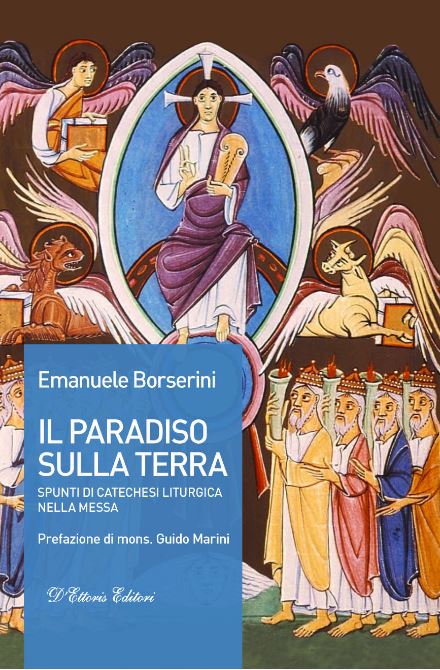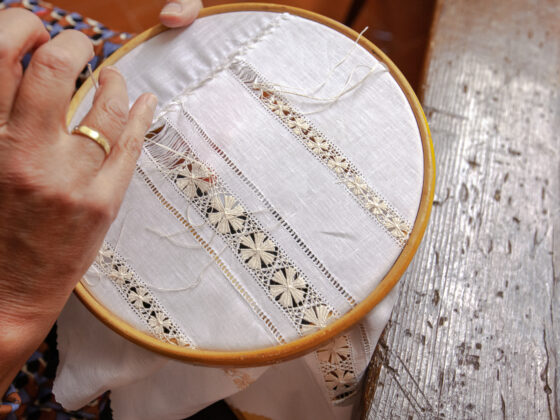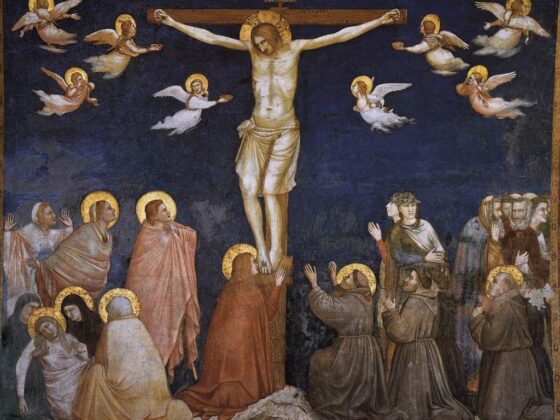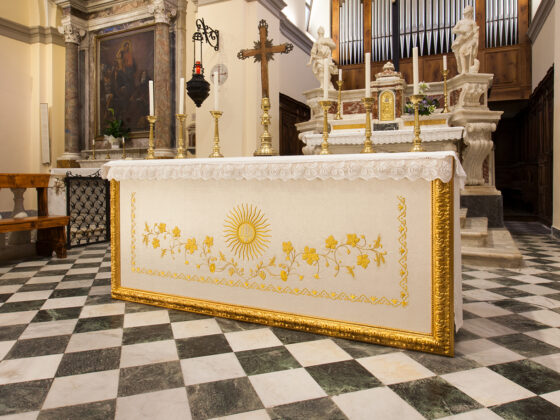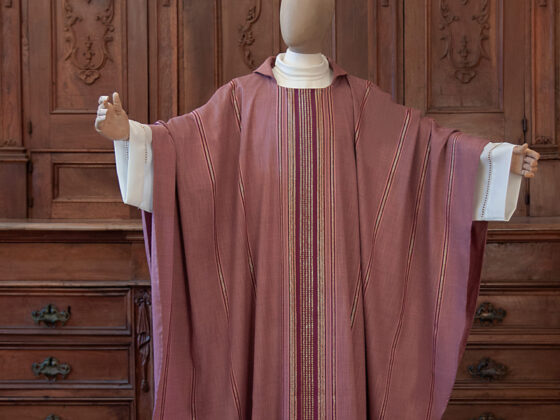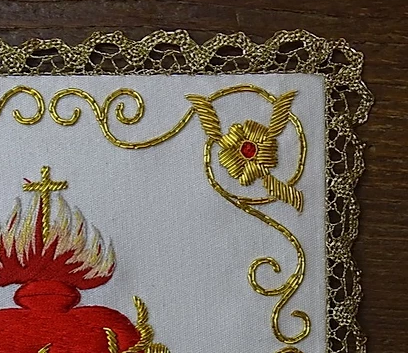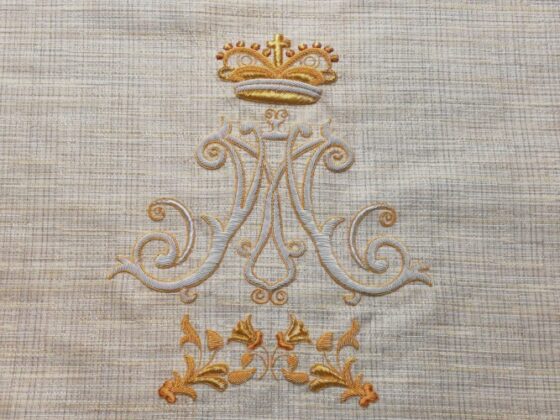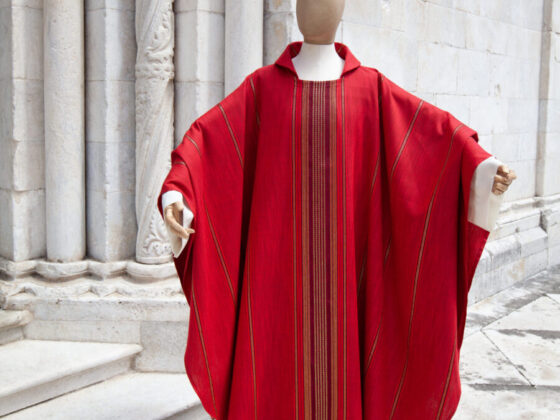Many of you are already on vacation, while others are waiting for August to take a break from daily routines and give rest not only to the body but also to the mind. Arte Ricami is also preparing for a short holiday period, and before leaving, we would like to share the book we’ve chosen to bring with us.
“Il paradiso sulla terra. Spunti di catechesi liturgica nella Messa” (Heaven on Earth: Insights into Liturgical Catechesis in the Mass) is a freshly printed book published in May 2018, written by Don Emanuele Borserini, a young and enthusiastic priest of the Fraternity of St. Philip Neri. He is the head of the Office for Cultural Heritage in the Diocese of Massa-Carrara-Pontremoli.
As a workshop specializing in hand-embroidered sacred vestments, we believe it is very important to continue deepening our understanding of the liturgy. Through our work, we aim to be part of what Pope Francis writes in Evangelii Gaudium: “The Church evangelizes and is herself evangelized through the beauty of the liturgy” (24). This book allows readers to shed light on many aspects of the Mass that may be difficult to understand.
In an interview with Radio Maria on May 31, 2018, the author shared an anecdote about St. Philip Neri: before and during the Holy Mass, this great saint needed to distract himself to avoid entering into ecstasy even before beginning the celebration and to prevent being completely enraptured by it. Why, then, is it so difficult today to remain fully present during the celebration, listening to the Word of God and the priest? Why is there a growing disaffection toward the Mass? These are some of the questions that prompted Don Emanuele to explore the meaning of the Mass, convinced that part of the new evangelization passes through the liturgy and a deeper understanding of it.

As Monsignor Guido Marini, Master of Pontifical Liturgical Celebrations, writes in the book’s introduction, Don Emanuele describes “the rite of the Eucharistic celebration with simplicity so that everyone can glimpse the extraordinary event we are involved in every time we participate.”
The book is structured following the division of the Missal: the Introductory Rites, the Liturgy of the Word, the Liturgy of the Eucharist, and the Concluding Rites. This structure allows readers to explore one section at a time or, as Don Emanuele puts it, to “illuminate even just one moment of the Mass at a time.” The book places the liturgical celebration at its center and serves as a tool for the faithful to fully engage with the Mass.
We share with you two pages from the book regarding the “behind-the-scenes” preparation of the priest for the Holy Mass and wish you a pleasant read and a happy holiday period.
Excerpt from the book:
“The sacristy is not a dressing room but a place of transition and purification. What takes place there is a true ritual, albeit preparatory. When the Church celebrates its liturgy, a universal upheaval occurs, tearing open the heavens and renewing the earth. To get an idea of this, we can read Psalm 29. This psalm has a distinctly liturgical structure, beginning with an invitation to praise the Lord in His temple, the place where liturgy ordinarily takes place (v. 2). It continues by describing the universal upheavals that occur during its celebration with marvelous and almost frightening imagery (vv. 3-9). There is also the response of the people who acclaim (v. 9), and it concludes with the powerful effect of the liturgy on the life of the people themselves (vv. 10-11). It is, therefore, an endeavor for strong and virile heroes; there is no room for weakness, frivolity, hesitation, uncertainty, or individualism…
The liturgy celebrates faith, the history of salvation, and life. We know that the entire history of salvation is a war against evil, reflected in and fought through the union of our personal spiritual battles with the one great salvific battle of Jesus. For this reason, adequate preparation is necessary to grasp this truth within the signs and words that will be enacted. The sacristy is the place where the priest and other ministers polish their armor and sharpen their weapons for the cosmic war they will lead, guiding the small army entrusted to them by the great King in a battle that ‘is not against flesh and blood, but against the Principalities and Powers, against the rulers of this world of darkness, against the spirits of evil in the heavenly places’ (Eph 6:12).
The symbolism of priestly vestments is entirely rooted in this warlike backdrop, expressed also in the vesting prayers proposed by the Missal—ancient prayers that, though reserved for the priest, can also illuminate our own preparation. The donning of priestly garments is a ritual moment accompanied by prayer because clothing, among the realities humans use, is perhaps the greatest vehicle of symbolism, rooted in nothing less than a gift from God, when He made garments of skin for our first parents after their expulsion from the Garden of Eden (cf. Gen 3:21). Just as the ministers wear special garments, so too should everyone feel called to dress in a particular way for Mass. This was once deeply felt, but we should recover it, as it expresses much more than a mere social convention that can now be considered outdated.”
From: Emanuele Borserini, Il paradiso sulla terra. Spunti di catechesi liturgica nella Messa, D’Ettoris Editori, Crotone 2018, pp. 44-45
For information about our products or for quotation requests please write to us at info@artericamiliturgico.com.
Follow us on FB paramentisacri.artericami e IN paramentisacri.artericami.
